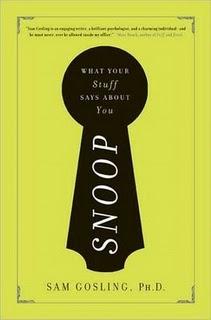Snoop: What Your Stuff Says About You

I hate to make the comparison, especially so quickly, but I will: Snoop is like Blink’s half brother. They aren’t technically related, but they live in similar worlds, have similar parents, and sometimes their content overlaps. That doesn’t mean Snoop is as interesting, but it’s a quick and easy read for anyone interested in the everyday applications of social psychology.
“Snoopolgy,” called a “special brand of voyeurism” by Gosling, is the behavioral science of understanding people based on the stuff they leave lying around, use to decorate their personal spaces, and what sorts of items they use day to day. Gosling, an associate professor of psychology, has been snooping on people since grad school, turning his curiosity into a methodology in the vein of those who study iPods for personality clues. The thing that makes this book fun is that while most of us think we can dissect the personality of another just by peeking behind their medicine cabinet, Gosling actually can. He proves it a number of times.
Gosling’s research extends to spaces like personal websites, Facebook profiles, and people’s cars, using clues from a variety of areas (work, home, play) to determine what makes people tick. Why, for example, is anyone ever really compelled to decorate? And what does it mean about them, whether they put up inspirational posters or sports memorabilia? These clues are then paired with personality tests like OCEAN (similar to the more well-known Myers-Briggs, or MBTI)—Gosling is a psychologist, after all, not just a sleuth—and the results tend to be interesting, if not always mind-blowing.
One of the most helpful parts of this book is the series of related studies and texts Gosling often referenced—both in his writing and in a sizable appendix. Thorough and thought provoking, this book won’t be a page turner for anyone without more than a passing interest in psychology, nor will it necessarily appeal to those who have already read similar work of Gosling’s contemporaries. But for a fresh look at how we assess first impressions—and how we sometimes screw it up—this is a great, accessible overview.